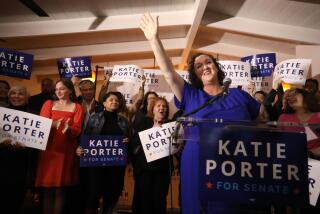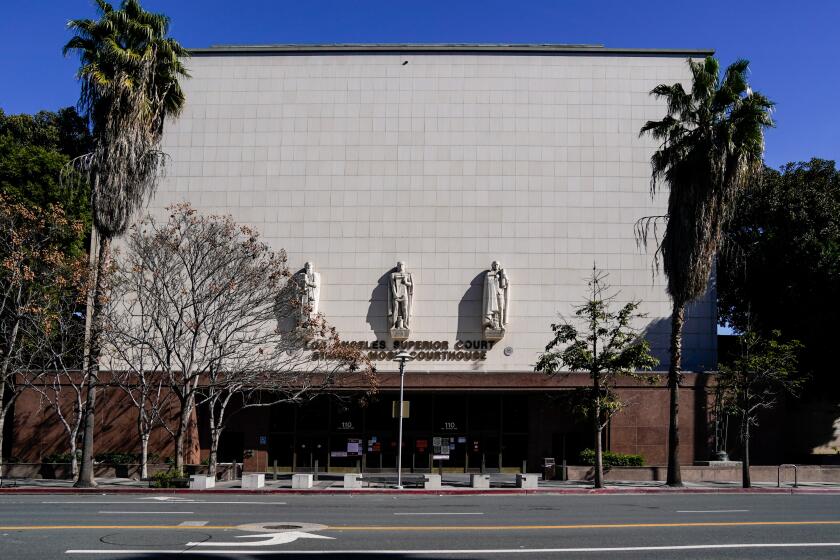Newton: Anaheim’s ballot battle
When Disneyland first opened to the public on a sweltering July day in 1955, the city of Anaheim wasn’t much more than an orange grove. It had all of 15,000 residents and was known mostly for its Halloween parade.
More than half a century later, almost everything has changed. Disneyland helped spur a development boom that has made the city California’s 10th largest. Once a suburban and almost entirely white town, it now is 53% Latino and about 15% Asian. Whites make up about 27% of the city’s population.
But one thing hasn’t changed. The city continues to elect its representatives just as it did in 1955: Four council members and a mayor all are elected by the city at-large. The result: Four of the city’s five elected leaders live in the wealthy, and predominantly white, area known as Anaheim Hills. Only one comes from the center of Anaheim, and none lives in the poorer, denser western part of the city.
PHOTOS: Residents pack Anaheim town hall
Mayor Tom Tait, an earnest Republican who has attempted to infuse Anaheim government with, as he puts it, “the core values of kindness and freedom,” recognizes the stresses that Anaheim’s election system has placed on its geographic and social fabric. Faced with an ACLU lawsuit challenging the city’s election rules, and convinced that reform is needed, Tait introduced a motion that would have allowed Anaheim residents to consider a ballot measure in November to create council districts and move their city into, if not the 21st century, at least the 20th. Districts, he said, would make for more effective representation, especially given Anaheim’s peculiar geography — it stretches more than 20 miles east to west while being compact from north to south, so council members who live at the far western end of the city are far from their constituents in the east — both geographically and socioeconomically.
“The vastness of the city,” he explained, “makes it hard to cover.”
And yet, by a vote of 3 to 2, he lost.
Tait’s colleagues protested, unconvincingly, that they’re not opposed to creating districts, just that they weren’t ready to endorse this particular proposal. Instead, they voted to appoint a committee to study the matter. At the same time, some have complained that districts would distort the city’s politics, replacing officials whose concern is for the overall welfare of Anaheim with more narrowly focused council members, inclined to defend their constituents at the expense of the city’s larger interests.
The crux of the matter is really self-protection. Because the Anaheim City Council was elected on an at-large basis, moving to districts almost certainly would cost some of those members their part-time jobs. Although the jobs pay only $18,000 a year, they also have good benefits, including a car allowance, and public officials aren’t often eager to give up power voluntarily.
But even if holding citywide elections makes short-term political sense for the current crop of council members, it’s bad public policy, legally risky and manifestly unfair. The lawsuit challenging at-large voting in Anaheim recites the city’s sometimes unsavory past in matters of race: In the 1940s, nonwhites were only permitted to swim in Anaheim public pools the day before they were cleaned; until 1957, Anaheim continued to segregate Latinos into so-called Mexican schools, even though California had legally outlawed such schools 10 years earlier. More recently, the Anaheim Planning Commission in 2002 opposed letting a Mexican grocery chain open a Gigante supermarket in a redevelopment project because it was felt to be “too Hispanic,” according to the lawsuit. The City Council eventually approved the project, but only after public outcry.
Racial tensions still divide Anaheim, which has been the scene of protests in recent weeks, as residents, many of them Latino, have claimed mistreatment at the hands of the city’s police. Tait’s proposal offered an opportunity for the council to demonstrate sensitivity to those concerns, but self-interest trumped broad-mindedness. “We have issues of people not feeling a sense of belonging,” the mayor said. “This would have been a great first step.”
It also would have saved the city what could be a costly and fruitless legal battle. Morgan Kousser, a Caltech professor and nationally recognized expert on voting rights, predicted that Anaheim will have a difficult time defending at-large elections and will have to spend heavily to do so. A similar case in Florida a few years ago ended up costing the defendants $2 million. “Does a municipality even as large as Anaheim want to spend $2 million in these times”? he asked.
Indeed, Anaheim leaders might consider the fate of Compton. The Anaheim lawsuit closely resembles a suit filed in 2010 against Compton, where an African American leadership was resisting district voting that might create more opportunities for Latinos, now the majority in that town. Compton resisted the litigation for more than a year, then eventually agreed to a settlement that put the matter before Compton voters. In June, nearly two-thirds of Compton voters approved the districts.
Jim Newton’s column appears Mondays. His latest book is “Eisenhower: The White House Years.” Reach him at jim.newton@latimes.com or follow him on Twitter: @newton_jim.
More to Read
A cure for the common opinion
Get thought-provoking perspectives with our weekly newsletter.
You may occasionally receive promotional content from the Los Angeles Times.







